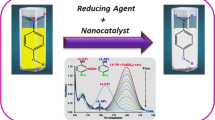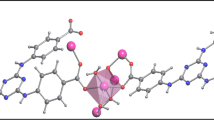Abstract
Vanadium-chromium composite oxides have held much interest due to their distinctive catalytic properties, which depend on their morphology and crystal structure. During the hydrothermal synthesis, reducing agents play an important role in controlling the morphology and the crystal structure of vanadium-chromium oxides. In this work, nanocrystalline chromium vanadate (CrVO4) were prepared by a simple one-pot hydrothermal method based on the reaction between V2O5 and CrO3. Three different CrVO4 crystal structures, including orthorhombic CrVO4, monoclinic CrVO4, and mixed-phased-CrVO4 were obtained by using different reducing agents. X-ray diffraction (XRD), scanning electron microscopy (SEM) and transmission electron microscopy (TEM) studies revealed that nanocrystalline monoclinic CrVO4 was obtained using tartaric acid as the reducing agent. Catalytic properties of nanostructured CrVO4 were investigated for the vapor phase ammoxidation of 2-chlorotoluene to 2-chlorobenzonitrile. The monoclinic CrVO4 nanostructures exhibited excellent catalytic performance due to the proper distribution of V-O-Cr bond. It was one of the most efficient binary catalysts for such vapor phase ammoxidation processes to the best of our knowledge, and may have great potential for the ammoxidation of halogen-substituted toluenes.
Graphical Abstract
Monoclinic CrVO4 nanostructures are controllably prepared by hydrothermal process using tartaric acid as reductant and exhibit excellent catalytic performance for ammoxidation of 2-chlorotoluene.











Similar content being viewed by others
References
Xie G, Huang C (2007) Indian J Chem Technol 14:371–375
Kalevaru VN, Lucke B, Martin A (2009) Catal Today 142:158–164
Krishnan V, Raju T, Muthukumaran A, Kulangiappar K (2009) Indian Pat 230374
Martin A, Kalevaru NV (2010) ChemCatChem 2:1504–1522
Martin A, Kalevaru NV, Lücke B, J. Sans (2002) Green Chem 4: 481–485
Dropka N, Kalevaru NV, Martin A, Linke D, Lücke B (2006) J Catal 240:8–17
Goto Y, Shimizu K, Kon K, Toyao T, Murayama T, Ueda W (2016) J Catal 344:346–353
Kubo J, Watanabe N, Ueda W (2008) Chem Eng Sci 63:1648–1653
Chieregato A, López Nieto JM, Cavani F (2015) Coord Chem Rev 301–302:3–23
Tang W, Liu Y, Ding S, Dong Y, Li T, Xie G (2022) Res Chem Intermed 48:4105–4118
Li X, Hu H, Chen P, Chen F, Yang S (2021) Mol Catal 516:111995
Xu L, Zhang Y, Deng Y, Zhong S, Mo YZ, Cheng G, Huang C (2013) Mater Res Bull 48:3620–3624
Dong Y, Li T, You X, You Q, Sun L, Xie G (2022) Res Chem Intermed 48:1151–1158
Xie G, Zhang A (2012) Synth Commun 42:375–379
Xie G, Zhang A, Huang C (2010) Res Chem Intermed 36:969–973
Touboul M, Melgite K (1995) J Mater Chem 5:147–150
Shishido T (2011) J Jpn Petrol Inst 54:225–236
Tang W, Zheng H, Dong Y, You Q, Li T, Xie G (2022) Mol Catal 518:112062
Baran EJ (1998) J Mater Sci 33:2479–2497
Bera G, Reddy VR, Rambabu P, Mal P, Das P, Mohapatra N, Padmaja G, Turpu GR (2017) J Appl Phys 122:115101
Jiang F, Deng S, Niu L, Xiao G (2013) Chin J Catal 34:1833–1838
Dhachapally N, Kalevaru VN, Radni J, Martin A (2011) Chem Commun 47:8394–8396
Huang Y, Li T, You Q, You X, Zhang Q, Zhang D, Xie G (2018) Chin J Catal 39:1814–1820
Song Z, Matsushita T, Shishido T, Takehira K (2003) J Catal 218:32–41
Kumar A, Dutta S, Kim S, Kwon T, Patil SS, Kumari N, Jeevanandham S, Lee IS (2022) Chem Rev 122:12748–12863
Chithambararaj A, Yogamalar NR, Bose AC (2016) Cryst Growth Des 16:1984–1995
Tan L, Wang F, Zhang P, Suzuki Y, Wu Y, Chen J, Yan G, Tsubaki N (2020) Chem Sci 11:4097–4105
Vidruk R, Landau MV, Herskowitz M, Ezersky V, Goldbourt A (2011) J Catal 282:215–227
Shishido T, Song Z, Kadowaki E, Wang Y, Takehira K (2003) Appl Catal A 239:287–296
Touboul M, Denis S, Seguin D (1995) Eur J Solid State Inorg Chem 32:577
Isasi MJ, Sáez-Puche R, Veiga ML, Pico C, Jerez A (1988) Mater Res Bull 23:595–601
Martin A, Lücke B, Wolf G, Meisel M (1995) Catal Lett 33:349–355
Babu BH, Rao V, Suh YW, Sai Prasad PS, Lingaiah N (2018) New J Chem 42:1892–1901
Dwivedi R, Sharma P, Sisodiya A, Batra MS, Prasad R (2017) J Catal 345:245–257
Rajitha P, Kumar PM, Mallesh D, Lingaiah N (2021) Mol Catal 515:111885
Babu BH, Venkateswar Rao KT, Surendar M, Sai Prasad PS, Lingaiah N (2015) React Kinet Mech Cat 114:121–134
Acknowledgements
This work was supported by the National Natural Science Foundation of China (21172269), by “the Fundamental Research Funds for the Central Universities”, South-Central MinZu University (CZY22010), by “the Major bidding projects of provincial and ministerial scientific institutions”, South-Central Minzu University (PTZD22007), and by “the Opening Project of Key Laboratory of Optolectronic Chemical Materials and Devices of Minstry of Education”, Jianghan Univeristy (JDGD-202220).
Author information
Authors and Affiliations
Corresponding authors
Ethics declarations
Conflict of interest
There is no conflict of interest for each contributing author.
Additional information
Publisher's Note
Springer Nature remains neutral with regard to jurisdictional claims in published maps and institutional affiliations.
Rights and permissions
Springer Nature or its licensor (e.g. a society or other partner) holds exclusive rights to this article under a publishing agreement with the author(s) or other rightsholder(s); author self-archiving of the accepted manuscript version of this article is solely governed by the terms of such publishing agreement and applicable law.
About this article
Cite this article
Liu, Y., Zhao, D., Tang, W. et al. Hydrothermal Synthesis of Monoclinic CrVO4 Nanoparticles and Catalytic Ammoxidation of 2-chlorotoluene. Catal Lett 154, 524–531 (2024). https://doi.org/10.1007/s10562-023-04305-2
Received:
Accepted:
Published:
Issue Date:
DOI: https://doi.org/10.1007/s10562-023-04305-2




